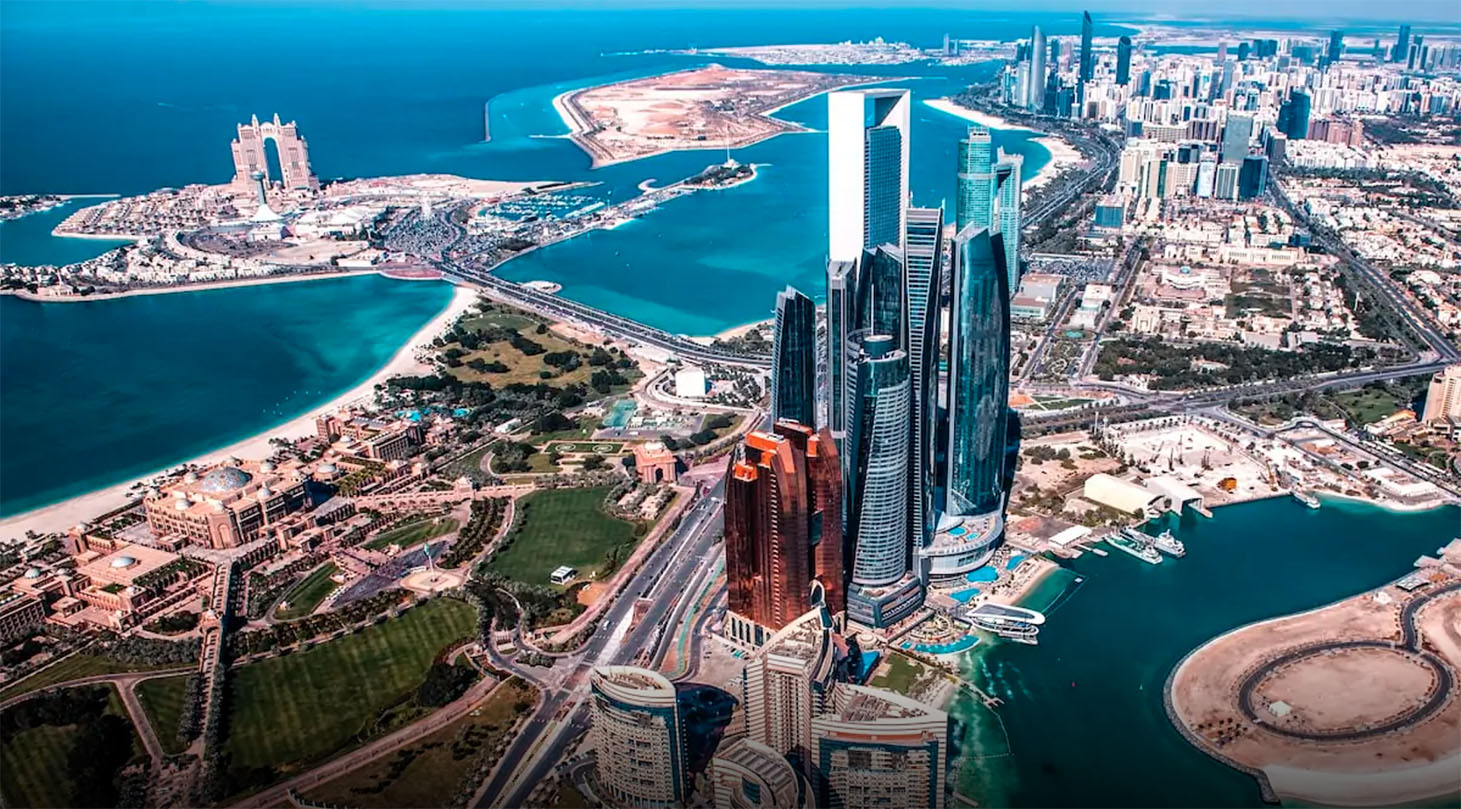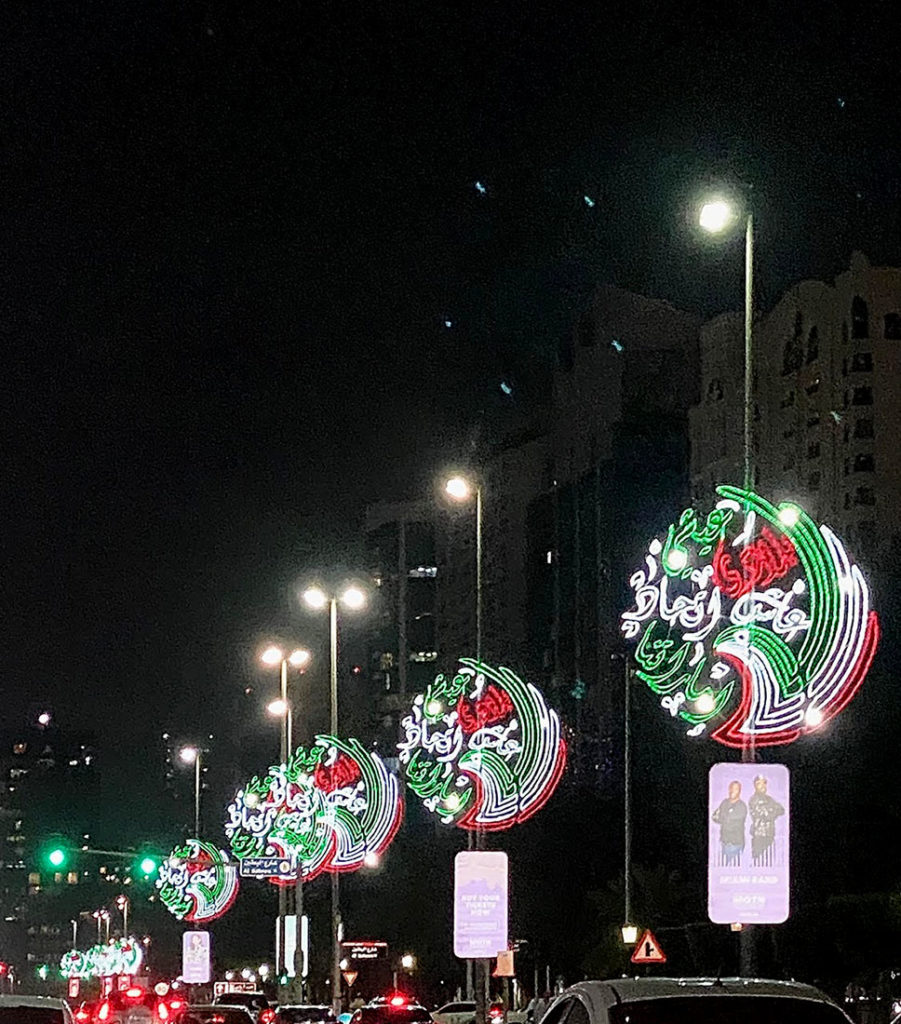
Deborah Williams
Early evening in Abu Dhabi and I’m sitting in traffic on the Sheikh Khalifa Bridge, which stretches over the inlet between Saadiyat Island and Abu Dhabi. The bridge and I have been in Abu Dhabi for about the same amount of time: the bridge opened in 2009, I moved here in 2011. This bridge was part of a project to develop Saadiyat as a “cultural hub” for the city and my husband remembers, on his first visit to Abu Dhabi in 2009, being driven over the just-built bridge, which the cab driver praised as an extraordinary achievement. My husband sent me photos: four lanes in both directions and no cars, the road arching over glittering water and then, on the Saadiyat side, unspooling across empty sand, bordered with a long smear of brilliant turquoise: the Arabian Gulf (aka the Persian Gulf).
Old-time Abu Dhabians remember Saadiyat as a destination for beach camping, reachable only by boat. Now there isn’t any empty space to pitch a tent and the beaches are mostly the province of the five-star resorts that sprawl along the coastline. Elsewhere on Saadiyat? The Louvre Abu Dhabi, NYUAbu Dhabi’s campus, several (for profit) K-12 schools, an offshoot of the Berklee School of Music (housed in the swooping building designed by Norman Foster as the UAE Pavilion at the 2010 World Expo in Shanghai), lots and lots of residential developments, and — the most recent addition — three buildings still swathed in scaffolding, destined to become the Abrahamic Family House, a campus that will include a mosque, a synagogue, and a church. Still to come? More museums, probably more housing developments, and doubtless a mall. Maybe two.

From empty sand to clotted traffic in a decade. Is that progress?
The UAE, of which Abu Dhabi is the capital, turned 50 at the beginning of December. 50 is the age when many of us start to look back as often as we look forward even as we tell ourselves that 50 isn’t that old, no matter the lower-back twinging or the creaking knees. For a country, though, 50 is an eyeblink, a flash, the rawest beginning, a newness that is complicated, in the case of the UAE, by the fact that its audacious forward motion exists in the context of an incredibly ancient part of the world. Old and new collide here in sometimes unexpected ways, like the time I saw an old woman with a gilt burqa across her face climb out of a Barbie-pink Hummer parked in front of Marks & Spencer.
In The Unfinished City, Thomas Bender examines the changes in New York City from the late 18th century to post 9/11, reminding us that while the city’s development may look inevitable from our vantage point, “nothing like it had ever occurred in the history of cities.” Bender’s book is focused on what he calls “the metropolitan idea,” and he uses NYC as his case study, but I think it’s an interesting way to think about Abu Dhabi, as well: as a city in a country that has developed well beyond what anyone could have imagined, and that is still very much unfinished, in the best possible way.
On December 2, 1971, when the UAE officially came into being, Abu Dhabi was little more than a handful of buildings along the coast and Dubai only slightly bigger. The engineer of this confederation was Sheikh Zayed bin Sultan al Nahyan, who became the first President of the UAE and the ruler of Abu Dhabi. A man with little formal education, Zayed believed that education for boys and girls was paramount, that other religions should be able to worship freely, that the natural environment should be protected, and that Islam “desists violence practiced by terrorists who kill their brethren and commit all despicable actions under the shelter of religion. Islam dissociates itself strictly from these people and their actions.” His politics were in many ways incredibly progressive. He also had seven wives and twenty-nine children. New ways and old, the country’s ongoing balancing act.
It used to surprise me that Zayed wasn’t a well-known figure in the States, but I guess to see him as a visionary leader would complicate the picture that many Westerners carry in their heads about the Gulf. Oil sheikh is the story, not “visionary progressive.”
Of course the country has flourished, people say, with all that money how could it not? As if somehow a flourishing country was an inevitable consequence of natural resources, when history (and our own contemporary moment) is littered with examples of precisely the opposite. True, oil wealth has made a lot of things easier, but when I talk about how that wealth gets used, I am told that I’m an apologist, somehow complicit in upholding a non-democratic state. So — taking a page from Cicero — I won’t tell you about the proliferation of schools, the efforts to safeguard the environment, the excellent medical care; I won’t tell you about the amazing public health initiatives that helped the country weather the pandemic (everything from PCR testing services that went door-to-door in poorer neighborhoods, free vaccines for all residents regardless of passport, PCR-testing price caps so that — unlike in Manhattan, for example — you don’t need to pay hundreds of dollars to get a fast-tracked test result); I won’t tell you about the relative ease with which the country accommodates a population that is more than 70% non-Emirati or what that means in terms of the swirl of languages, food, religions, and customs that fill daily life in the UAE.
I’ll tell you instead about what it means to live prepositionally, which is, in fact, inevitable in a city where new roads pop up with astonishing regularity. We talk about living next to that building, behind the shop, around the corner with the flagpole, under the giant billboard. Taxi directions to the first NYUAD campus came out as a single phrase: behind the ADIA tower on the site of the old fish market across from Marks & Spencer mall. There are more street names now — and street signs — but cab drivers and Google Map Master are often a bit sketchy on those details (resulting in being told to take a left into a sandpit, or going the long way around something because the new road isn’t yet mapped). And just as daffodils are harbingers of spring in damper climates, the sudden appearance of stoplights in an otherwise empty patch of desert signifies that a new housing development is about to sprout. I think of these stoplight clusters as aspirational intersections: install the lights, the rest will follow.
Is it a perfect place? No, of course not. Is this current level of growth sustainable? I’m not sure. Financially, perhaps yes; environmentally and socially, perhaps not (those traffic jams are getting worse). Because it is a small country the problems it confronts may seem extreme, but they’re versions of the same problems being confronted by countries around the world: the depredations of global capitalism, the urgency of climate crisis, restrictions on public discourse and journalism, the threat of fundamentalism of all sorts, the cataclysmic disparities in wealth and education. And yet when I look at how the UAE is wrangling with these issues, I feel a sense of optimism, whereas when I look at what’s happening with these issues “at home,” in the United States, I feel something much closer to despair. Is that the optimism of the country’s youth seeping into my perspective, the “I can handle this” swagger of a young country?
The first year I lived here, I took a stroll along the Corniche one evening in late November. Fresh from the States, it seemed to me totally normal that around Thanksgiving (which a group of us celebrated on a Saturday), the city would twinkle with red, white, and green lights, in festive curlicues and star shapes. Christmas lights, I thought, and then stopped. Wrong holiday. Not Christmas. National Day: the UAE flag is three bold stripes of white, green, and black, with a red rectangle positioned on the flag’s short edge.
It’s like cultural synesthesia and it hits me every year. The stores are bedecked with portraits of Zayed and Santa Claus (and recently, daringly, a few menorahs); the signs in the shops wish you a Merry Christmas, in both English and Arabic; there are National Day sales and “Black Friday” sales (in a country that does not celebrate Thanksgiving); there are National Day pageants staged to honor the past and firework displays that celebrate the future. Sheikh Zayed once said that “History is a continuous chain of events. The present is only an extension of the past.” His comment reminds me of what Bender says in his book about Manhattan: that most great cities are eternally unfinished, their urban fabric a continuous weaving (and unweaving) of “the familiar and the new, nostalgia and adventure, the archaic and the novel.” The spangled cosmopolitanism of National Day: one thread. The thickening traffic all over the city: another thread. Bridges connecting islands: another thread. The Hindu temple being built in Jebel Ali, the intricate blue mosque being built along the Abu Dhabi Corniche: more threads. So much has happened and there is so much more yet to come.
50 is not at all old for a country and living here makes me think that, hell, maybe it’s not that old for a person either.




PCR tests in NYC are in fact free. In Egypt and elsewhere in the Arab world, and in Canada and many European countries, PCR tests can run up to $200, depending upon the specific test.